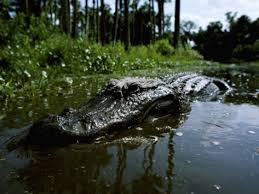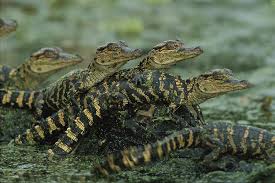The Alligator: Man-Eater or Misunderstood?
By Gemma Angel, on 1 July 2013
 by Sarah Savage
by Sarah Savage
While browsing the cases during an afternoon’s engagement session in the Grant Museum, I spotted a very familiar face from my life in New Orleans: the American alligator. As one of the largest, most terrifying reptiles I have ever encountered in real lofe during my walks in the Louisiana swamps, the alligator earns my respect as the king of the wetlands. Staring into the display case, a young student visitor from London approached and remarked, “Is that a dinosaur?!”
Despite the alligator’s large, scaled form reminiscent of a prehistoric water monster, the alligator is of course not a dinosaur. The student appeared quite distressed that alligators still exist and live in the swamps in the southern United States. I described what it is like to observe a wild alligator in person, only seeing the large eyes above the water at first, until the beast decides to fully surface.
Although the alligator is a predator, it does not pose a direct threat to human visitors in the swamps as long as a distance is maintained between the visitor and alligator. When I was quite young, I remember learning how to outrun an alligator if by chance our paths crossed. Since alligators are remarkably fast ambulators on land, it is best to run in a zig-zagging line if you find yourself being chased by one of these prehistoric-looking creatures. Due to the nature of the alligator’s short legs and long, heavy body, it is difficult for alligators to make sudden turns. The young visitor to the Grant was also intrigued by the long, sharp teeth visible in the alligator’s jaw in the display. Alligators can have between 2,000 and 3,000 teeth over a lifetime, as new teeth replace those that become damaged. The muscles within an alligator’s jaw are very powerful, allowing the jaw to quickly snap shut on prey to prevent it from escaping. In fact, the pressure of an adult alligator’s jaw is approximately 300 pounds per a square inch. Luckily for humans, an alligator’s primary diet consists of fish, birds, amphibians, small reptiles such as snakes and turtles, and small mammals living in the wetlands. Examples of these small mammals include rats, nutria, mice, opossum, squirrels, raccoons, muskrat, and infant deer. Although some of an alligators’ prey can be quite small, occasionally alligators can feed upon fully-grown deer or feral boars. There are occasional alligator attacks on humans – however, most of these are a case of mistaken identity. Unlike the alligator’s cousin, the crocodile, which will actively hunt humans, alligators are wary of contact with humans.
Upon further examination of the alligator and crocodile skulls in the display case, I noted two very distinct features that are classic indicators which distinguish between the beasts. The first feature is the relative shape of their skulls. The alligator has a broader snout than the thin, long snout of the crocodile. Secondly, the alligator has larger, wider teeth as compared with the long, thin teeth of the crocodile. In the Audubon Zoo in New Orleans and on swamp tours in Southeast Louisiana, a visitor can even hold a baby alligator without the threat that the alligator will turn on the human. Although not the most conventional of baby animals to hold, baby alligators have smooth, scaly skin and soft underbellies. Beware of baby alligators in the wild though; their human-like cries, similar to those of a human child’s, mean that there is very likely a ten-foot or larger mother alligator nearby lurking just under the surface of the water.
However, from the safety of the Grant Museum, visitors can examine alligator and crocodile skeletons up close.
 Close
Close





